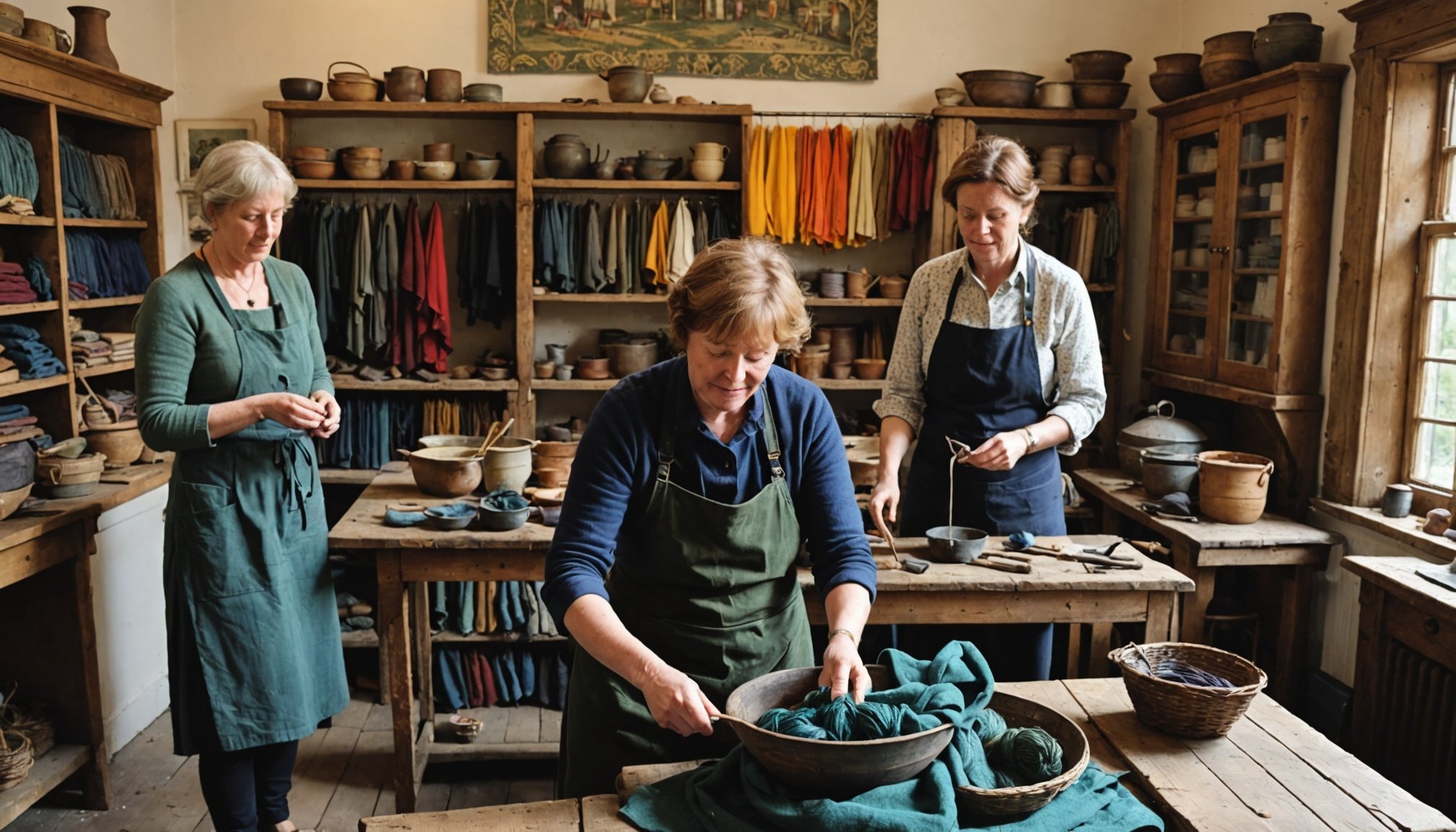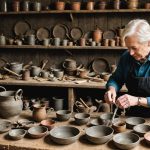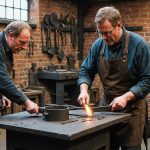Overview of Traditional British Textile Dyeing
In the vibrant history of British culture, traditional textile dyeing holds a place of significant importance. Over centuries, it has crafted a rich tapestry of colours that have adorned British textiles, intertwining art and daily life. Traditional techniques were once indispensable in creating garments and fabrics that illustrated societal status and aesthetic values.
British textile dyeing has historically relied on both natural and synthetic dyeing techniques. Early methods prominently featured natural dyes, derived from plants, minerals, and animals. Popular examples include dyes from madder root for reds, woad leaves for blues, and cochineal insects for vibrant crimson. The popularity of synthetic dyes emerged much later in the 19th century, allowing for a broader range of colours and improved fabric durability.
In the same genre : Explore the Top UK Festivals for a Deep Dive into Enchanting British Folk Tales
Integral to textile art, the dyeing process depends on a variety of key materials and tools. These include dye vats, mordants, and resist agents, each crucial in setting colours and creating complex patterns. Tools such as shuttles and heddles also play a vital role, facilitating intricate weaves and designs.
British textile dyeing represents a blend of art and practicality, telling stories through every hue while nurturing England’s textile heritage. This craft continues to evolve, adapting ancient methods to meet modern aesthetic demands.
In parallel : Discover the Top UK Destinations for Expert Workshops in Traditional British Tapestry Weaving
Types of Workshops Available
Exploring your creativity through workshops is an enriching experience. These workshops often cover a range of interests and skills, from introductory sessions to more advanced classes.
One-Day Workshops
These are ideal for those with tight schedules looking for a quick creative fix. One-day workshops are designed to provide a hands-on experience. They often focus on specific techniques, like textile dyeing, allowing participants to create tangible results in just a few hours. The short duration makes them accessible to beginners and those experimenting with new hobbies.
Multi-Day Courses
For an immersive experience, multi-day courses offer a more in-depth dive into creative practices. These workshops are perfect for individuals looking to develop a deeper understanding of their chosen field, such as advanced textile dyeing methods. They usually cover extensive topics, allowing participants to refine their skills considerably.
Family-Friendly Sessions
Tailored for families, these sessions focus on crafting experiences that can be enjoyed by all age groups. They aim to foster creativity and teamwork, making them perfect for family bonding. Such workshops often accommodate varying skill levels and can include fun projects ranging from simple tasks for children to more complex creative experiences for adults. Workshops, with their flexibility, can be arranged to fit the schedules and sizes of different groups.
Locations for Textile Dyeing Workshops
Exploring the creative world of textile dyeing in the UK is a vibrant experience enriched by visiting distinctively unique workshops spread across various regions. Each offers remarkable methodologies and inspirations.
Yorkshire stands as a hub for artisans, featuring workshops nestled among scenic landscapes and rich textile history. Facilitated by both local experts and visiting specialists, these workshops often include bespoke sessions tailored to personal interests.
Unsurprisingly, London boasts a plethora of workshops, fuelled by the city’s artistic energy and innovative spirit. Many workshops here offer comprehensive courses, allowing participants to engage with contemporary techniques alongside traditional methods in a cosmopolitan atmosphere.
In Scotland, the textile dyeing scene is intertwined with its cultural fabric, offering workshops that highlight the region’s celebrated heritage. From urban centres like Glasgow to the stunning Highlands, these locations provide immersive experiences often focusing on natural and sustainable dyeing practices.
Reaching these workshops is typically convenient, with easy access from major transportation hubs:
- Yorkshire workshops are well-connected by rail and road.
- London is accessible via extensive public transport options.
- For Scotland, both trains and regional airports serve most major workshop centres.
Each region offers its own distinct flavour, making it a significant destination for enthusiasts and professionals alike to explore the vast potential of textile dyeing.
Booking and Costs
Navigating the process of workshop booking can be made easier with a step-by-step guide. To book a workshop online, begin by visiting the official website of the provider. Choose your desired workshop and add it to your cart. Follow the prompts to enter your details, and proceed to payment. If you prefer booking via phone, call the listed contact number, provide the necessary information, and confirm your spot.
When considering the cost of workshops, it’s important to be aware of the variations. Costs often depend on the workshop’s nature and the materials required. An arts and crafts session may be relatively affordable, whereas specialised courses, like photography, tend to be pricier. The average cost is typically between £30-£150 per session.
For those conscious of budget, there are budget-friendly options to explore. Many providers offer early bird discounts. Subscribing to newsletters can yield special offers, and some platforms provide group booking discounts. It’s helpful to check periodically for seasonal promotions, which can significantly reduce costs and give access to high-quality workshops at a fraction of the price.
Testimonials and Success Stories
Engaging with participant experiences provides valuable insights into the benefits of workshops. Past attendees often share transformative narratives, highlighting the profound personal growth they experienced. These stories serve as testament to the workshops’ effectiveness in fostering both skill development and self-confidence.
In their reviews, many participants emphasize the importance of community. The connections formed during these workshops extend beyond the sessions, creating a supportive network. This sense of belonging plays a crucial role in fostering student outcomes. The interactions and exchanges within the workshop environment encourage collaboration, learning, and innovation.
One inspiring success story involves a student who utilised the skills and connections gained to launch a successful business. Their story illustrates how workshops can provide the tools and network necessary to turn ideas into reality. This is just one example of the many success stories that have emerged from these workshops.
Participants repeatedly highlight the welcoming atmosphere, engaging content, and lasting impact on their personal and professional lives. Such feedback underscores the workshop’s lasting effect on driving innovation and inspiring new ventures. As these testimonials show, the journey of learning in a collaborative setting strongly influences workshop reviews and participant satisfaction.
Cultural Insights and Historical Context
The cultural tapestry of British craftsmanship is richly interwoven with the history of textile dyeing. This craft holds a vital place in the nation’s heritage and industrial growth. Textile history in Britain is not just about fabric production; it’s a vivid narrative of colour and artistry that has shaped cultural identity over centuries. Textile dyeing played a significant role, often reflecting and influencing economic and social changes.
Throughout history, notable figures emerged, leaving lasting impressions on the textile industry. In the 18th and 19th centuries, pioneers like William Morris stood out. Morris was not only a designer but an advocate for traditional craftsmanship, influencing the Arts and Crafts Movement. This movement celebrated hand-dyeing techniques, countering industrial mass production, and emphasising the cultural significance of textiles.
Although technology has transformed textile practices, traditional methods continue to inspire modern textile practices. Techniques perfected over centuries are now integrated with contemporary designs, reflecting a harmonious blend of past and present. The legacy of British textile craftsmanship endures, offering insights into cultural evolution and inspiring future innovation in the industry.
By understanding these historical contexts, we not only appreciate the aesthetic but also the cultural significance that British textile dyeing brings to the global stage.











